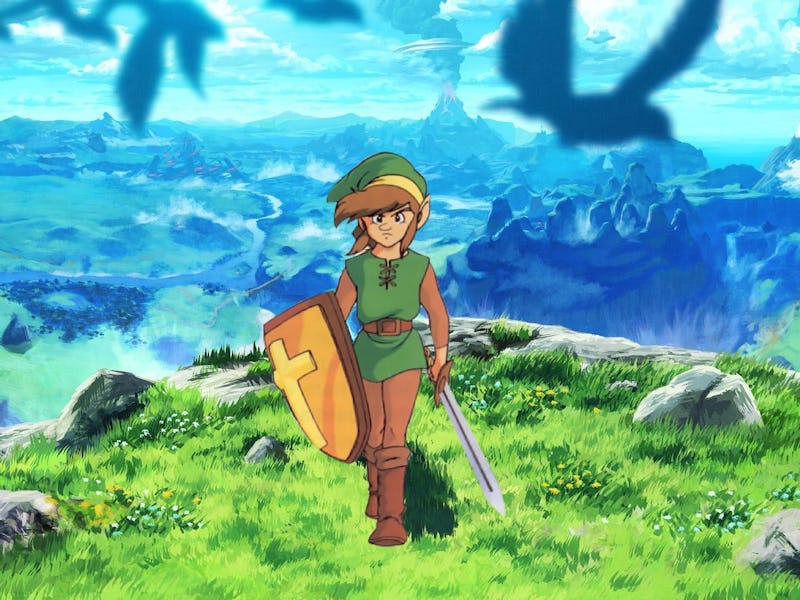You need to play the most divisive Zelda game ever on Nintendo Switch ASAP
The most experimental Zelda game ever is surprisingly excellent.

Zelda II: The Adventure of Link is not a game remembered fondly by many.
Shigeru Miyamoto, producer of the game and creator of the world of Zelda at large, once told Kotaku that while he doesn’t think he’s ever made a bad game, “a game I think we could have done more with was Zelda II: The Adventure of Link.”
Zelda II is a radically different game than the rest of the series, an outlier for any number of reasons, starting with the sidescrolling gameplay and the XP system. But while it might not be the definitive 2D-Zelda experience, its odd style is worth exploring for any player who wants a challenge.
If you’re a paid Nintendo Switch online subscriber, you can play Zelda II: The Adventure of Link. right now by downloading the Nintendo Entertainment System app.
But first: What are your favorite games and platforms of 2021, and what future releases are you most excited about? Take our poll!
A big sword is front and center here.
As soon as the modern player starts Zelda II, they’ll notice something different about the game: plot continuity. The game starts with a gorgeous opening screen, featuring a sword buried deep into a seaside rock. It explains that after the events of the first game, Princess Zelda has fallen into a deep sleep.
The game’s manual, which players at the time would have had handy, goes into greater detail. Six years after he defeated Ganon as a 10-year-old, a mysterious Triforce-shaped mark has developed on Link’s hand. As a teenager confused about changes in his body, he wisely seeks out Impa, Princess Zelda’s nursemaid. She reveals to him that these marks open the door to a different Princess Zelda, who is trapped in a cursed sleep. What’s more, Ganon’s followers are after Link, trying to capture his blood to get their master back.
In light of all the lore and table-setting in the manual, the game itself doesn’t have an opening cinematic at all. That alone makes it feel like a relic from a lost era where games relied on their manuals a great deal. So Zelda II throws the player right into the hall of the sleeping Princess Zelda, where the game’s next big change is noticeable: a side-scrolling Link. See him go left! See him go right! That’s it!
Look at Link go!
Adventure of Link uses two visual styles: There’s a top-down map which Link walks through, moving from town to town, cave to cave, and so on. But whenever he’s in one of those areas, or enters any combat, it immediately switches over to side-scrolling. There are weaknesses here: In towns, for example, the people moving back and forth can get confusing when you’re trying to figure out who exactly is supposed to give you the Shield Spell. Dungeons can disorient you as well, and playing with a walkthrough is recommended, at least to get a clear sense of direction.
It’s easy to see why Link to the Past switches back: That game’s dungeons feel unique and handcrafted, radically different from other games at the time. Adventure of Link feels like other NES games: There are aspects of Metroid here, moving back and forth to find keys and potions. But there’s also a bit of Mario in its DNA.
This feeling of familiarity might be what Miyamoto found disappointing: "When we're designing games, we have our plan for what we're going to design but in our process, it evolves and grows from there," Miyamoto told Kotaku. "In Zelda II: The Adventure of Link, unfortunately, all we ended up creating was what we had originally planned on paper."
But when compared to other side-scrollers of the time, Adventure more than holds up. The game’s enemies are vivid and range from silly (the barely mobile blobs Link first faces to level up) to downright scary, like the game’s Stalfos skeleton sprites.
Get that skeleton, Link!
And while Miyamoto also noted to Kotaku that the technical limitations of the game prevented larger enemies, having them all on Link’s level provides a certain intimacy. After all, rather than ending on a big boss, Adventure ends with the debut of one of the series’ most enigmatic villains: Dark Link.
It’s telling that while Adventure of Link became generally regarded as the black sheep of the Zelda series, its influence can be felt on both the series and a variety of other games. While the towns are a bit busy, there’s a real sense that they exist beyond Link coming to visit, with people scurrying around one way or another. Concepts like the Triforce of Courage first appear here, as well as metered-out magic and spells.
Adventure of Link isn’t a perfect game, but it’s a fun challenge for a player looking for a break from Breath of the Wild.